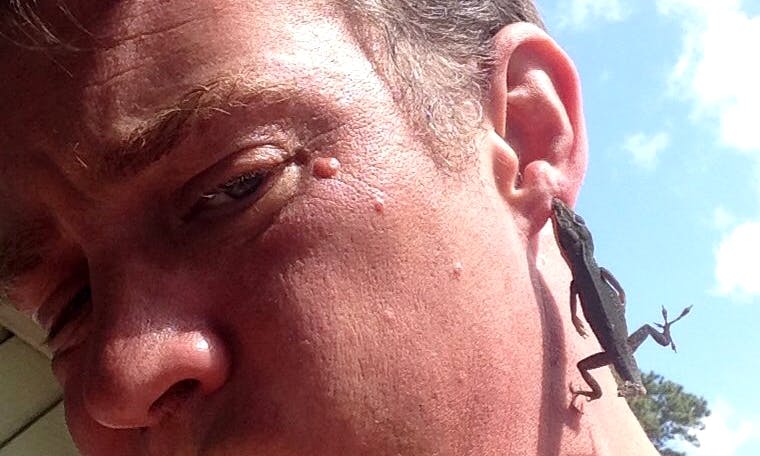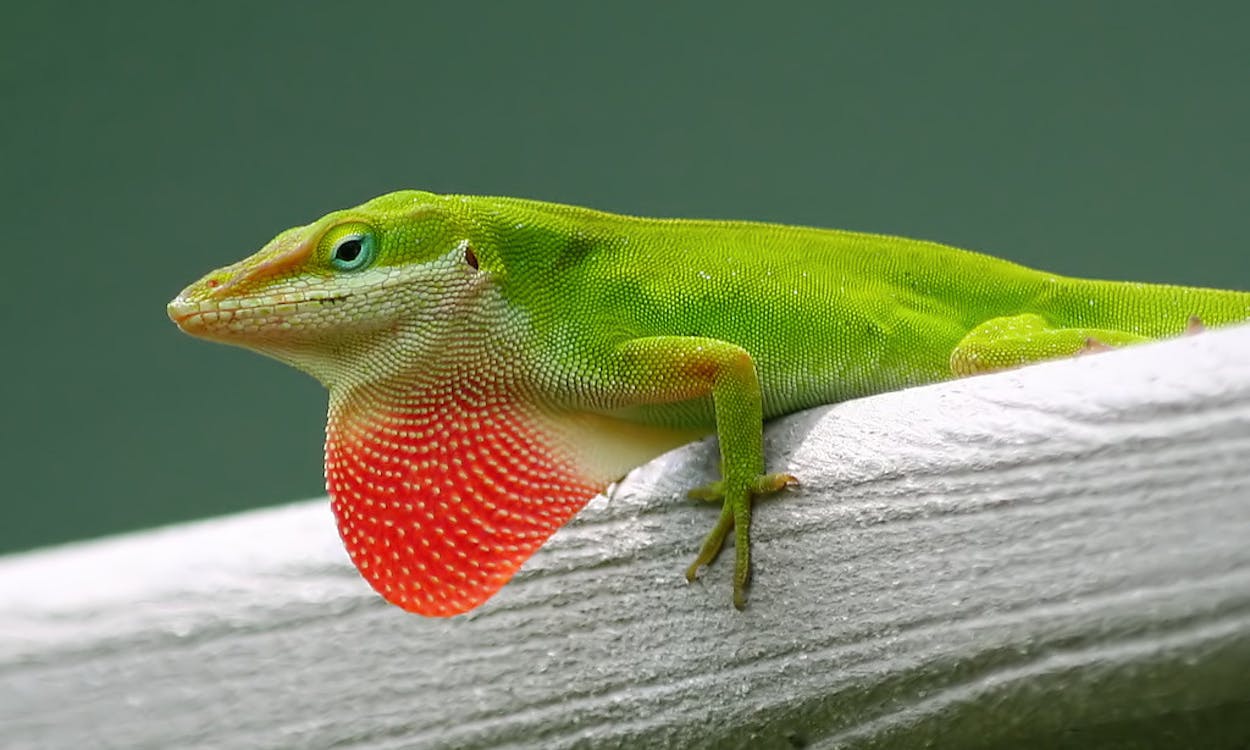When I first moved to the Houston Heights area, the bulk of the lizard population in our backyard consisted of the same old critters I’d grown up with: the green anole. “Green” is something of a misnomer, because they can change from a sort of bright Gatorade hue to various shades of brown, prompting some to erroneously call them “chameleons.” It’s a Houston backyard rite of passage to catch these “push-up” fanatic, throat-inflating lizards, let them clamp their jaws on your earlobes, and sport them as reptilian accessories, like so:

But that was one of the last green anoles I’ve seen in my backyard. Almost all I ever come across now are brown anoles, a relatively recent invasive species from the Caribbean that has displaced Texas’s native-born lizards in ever-increasing numbers. Also known as the Cuban or Bahamian anole, its skin is patterned with diamonds and faint stripes and never turns green, but does cycle through various shades of brown.
Anole expert Yoel Stuart, a Harvard Ph.D. and post-doctoral researcher at UT-Austin, has studied brown and green anoles and their interactions everywhere from Florida—where they first arrived in the U.S. and are now estimated to be that state’s most abundant land vertebrate—to West Texas, where their population growth is partially stymied by desert-like conditions. Stuart believes that the brown variety has been hitching rides in potting soil all these years, first on ships coming in from Cuba and the Bahamas, and now they are fanning out across the South in the back of eighteen-wheelers, their eggs or hatchlings burrowed deep in sacks of dirt.
As of a few years ago, Texas brown anoles were most abundant in and around garden centers at places like Lowe’s, Home Depot, and Walmart. That was where Stuart studied them in Texas in 2009, in both Houston and Corpus Christi. Since then they’ve either migrated on their own or hitched rides aboard potted plants to backyards all over those two cities and San Antonio as well. “They are good at living in an urban environment,” Stuart says. “In more arid environments, as you move west in Texas, it seems like they need that urban environment, because you get a lot more watering. We tried to catch a few in the drier regions of Texas and didn’t find much.”
They’ve certainly thrived in our urban environment. You can see a Florida-like future of total brown anole dominance if you cycle down Houston sidewalks in some inner-city neighborhoods. There you’ll see a steady stream of them scuttling across the sidewalk, a dozen or more in each block, some unlucky ones running under wheels or feet. On a recent stroll around Houston’s Museum District, one such lizard ran directly under my kid’s tennis shoe, but they’ve become so abundant that even my animal-loving daughter could scarcely work up more dismay than she would over a crushed june bug.
Since 2009, our yard has been over-run with the speedy invaders. Unlike the greens, our cats seldom catch them. Land speed is a big component of their adaptation to their ecological niche, Stuart says. In their native Cuba, they’ve been competing with rival anole species for millions of years, and developed the bodies and skills best suited to occupying turf on the ground and low on tree trunks.
Our green anoles had all of America to themselves for four million years, Stuart says. It was a pretty cushy life: lots of bugs to eat, trees and bushes to climb, with only snakes and birds of prey to harsh their mellow existence. Then Europeans arrived, bringing their cats with them, and the green anoles had another sworn enemy, but one that pales in comparison to their spikier, fiercer, and uglier cousins from Cuba.
But they are adapting as fast as they can. On islands off the coast of Florida, Stuart studied the green response to the brown invasion and was astounded at the speed of the green anole’s evolution. Because the brown anoles devour green anole babies whenever they can, the grass-colored variety learned to flee to the treetops high above brown anoles as soon as they were able. And to facilitate life in the canopy, in just 20 generations the greens developed toe pads much better suited to climbing and gripping branches than they’d ever had before. To put it in human terms, today’s average American male is 5’9, Stuart points out. If we evolved at the same pace as the anole, in 20 generations, our average would be a towering 6’4, a nation of Troy Aikmans and Dwyane Wades.
So that’s one reason we’re not seeing the green anoles as much anymore. Where the browns are present, they are way up high in the pines, pecans and oaks, seldom venturing down into our lines of sight. Which is not to say they are just as abundant now as they were a few years ago: Stuart says the sheer number of browns has to have some negative impact on the food supply the two species share.
“Even though they are moving up wherever they can, their population densities are likely dropping, but probably not enough to go extinct,” Stuart says. “Maybe locally extinct in some places, where there is not enough tree cover for them to retreat to.”
There doesn’t seem much to be done to reverse this Caribbean reptilian invasion—or is there? How about this modest proposal: If you or your cat is quick enough to catch them, it’s said that sprinkled with salt and pepper and fried in oil whole, brown anoles taste a lot like bacon, making them a delicious salad topping. (As with chickens and all reptiles, you must wash them first as a precaution against salmonella.)
Bon appétit.







